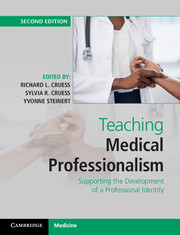Book contents
- Frontmatter
- Contents
- List of contributors
- Foreword
- Introduction
- Part I What is to be taught and learned
- Part II Theory
- Part III Principles
- 8 General principles for establishing programs to support professionalism and professional identity formation at the undergraduate and postgraduate levels
- 9 Faculty development to support professionalism and professional identity formation
- 10 Becoming interprofessional: professional identity formation in the health professions
- 11 Assessment of professionalism and progress in the development of a professional identity
- 12 Remediation of unprofessional behavior
- 13 Professional identity formation, the practicing physician, and continuing professional development
- 14 Professionalism, professional identity, and licensing and accrediting bodies
- Part IV Case studies in promoting professionalism and professional identity formation across the continuum
- Part V The future
- Index
- References
11 - Assessment of professionalism and progress in the development of a professional identity
from Part III - Principles
Published online by Cambridge University Press: 05 April 2016
- Frontmatter
- Contents
- List of contributors
- Foreword
- Introduction
- Part I What is to be taught and learned
- Part II Theory
- Part III Principles
- 8 General principles for establishing programs to support professionalism and professional identity formation at the undergraduate and postgraduate levels
- 9 Faculty development to support professionalism and professional identity formation
- 10 Becoming interprofessional: professional identity formation in the health professions
- 11 Assessment of professionalism and progress in the development of a professional identity
- 12 Remediation of unprofessional behavior
- 13 Professional identity formation, the practicing physician, and continuing professional development
- 14 Professionalism, professional identity, and licensing and accrediting bodies
- Part IV Case studies in promoting professionalism and professional identity formation across the continuum
- Part V The future
- Index
- References
Summary
Introduction
Over the past few decades, the focus on professionalism has increased dramatically throughout the continuum of medical education. It is now considered an essential component of competence in a variety of countries including Canada (CanMEDS roles), India (Medical Council of India Regulations on Graduate Medical Education, 2012), the United Kingdom (Good Medical Practice), and the United States (ACGME competencies).1–4 The emphasis on competencies such as professionalism reflects a shift to a model that starts with the desired educational outcomes and works backward to define the educational process.
Assessment is central to outcomes-based education. It constitutes the means by which stakeholders are assured that learners have achieved the competencies necessary to meet the needs of the community. For students, it offers guidance regarding milestones in their development.5 In addition, there is a growing appreciation of the critical role of formative assessment and feedback in both learning and identity formation.6 This chapter will address the assessment of professionalism by (1) outlining the challenges, (2) citing reasons for assessing it, (3) using Miller's pyramid as a framework for describing some of the methods of assessing professionalism and the research that supports them, and (4) suggesting some principles for developing an assessment system for professionalism. We conclude with brief consideration of lessons learned and future directions.
At the outset we note that many chapters in this book are focused on professional identity formation, rather than professionalism. Identity formation as a process has been studied for decades.7,8 Recently, the literature has explicitly addressed the question of how the process of medical education supports and enhances professional and clinical identity formation.9–11 We see professionalism and professional identity formation as two largely overlapping bodies of work. Because our task in this chapter is to address assessment, and there is a rich literature in the area, we chose that body of work for our focus. The goals and methods of assessment generally align with how students perform – as of yet they are not well developed (and perhaps they should not be?) for judging what a person is. Nevertheless, many of the tools and processes we review and the ideas behind them are readily adaptable to the concerns underlying professional identity formation, such as reflections, attitudes, and behaviors.
- Type
- Chapter
- Information
- Teaching Medical ProfessionalismSupporting the Development of a Professional Identity, pp. 155 - 168Publisher: Cambridge University PressPrint publication year: 2016
References
- 6
- Cited by



